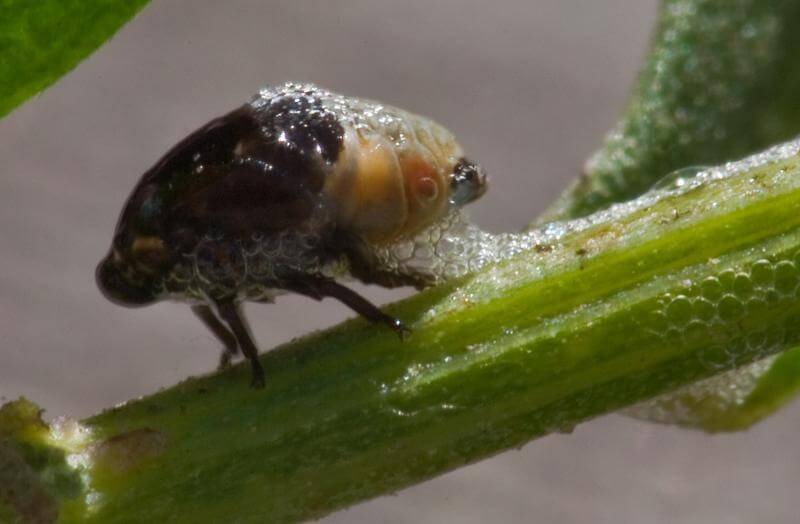Spit Bugs and Soapsuds: The Safety Of Tiny Bubbles
by Pat Tucker
Broadcast 7.21 & 7.24.2020

Nymphal froghoppers (superfamily Cercopoidea) avoid desiccation and predators inside a froth of plant sap. Photo by Michael L. Baird (CC 2.0).
Listen:
If you take a walk through fields this time of year, you can’t help but notice what looks like gobs of frothy white spit on the stems of grasses and weeds. If you brush away the spit, you’ll find a bright green froghopper or spit bug with shiny black eyes.
In a few weeks it’ll have wings and hind legs that can propel it great distances – hence the name frog hopper. But at this stage of its life, all it can do is crawl. And since its body is soft and subject to drying out, it needs a way to protect itself from enemies and the sun. It does so with spit. But the spit doesn’t come from the bug’s mouth.
As a spit bug sucks the sap from a plant, its body absorbs the nutrients and adds a chemical that makes it soapy. This liquid trickles out of its tail and forms a pool. Now the spit bug begins to make bubbles. Only instead of blowing through a straw as into a bowl of soapy water, it uses a row of plates on its underside that open when the bug raises its tail and close when it’s lowered, much like a bellows we might use to fan a fire. The air forced into the liquid by this movement bubbles and froths and the spit bug is soon covered by a mass of foam. It takes a spit bug about fifteen minutes to build a new home when it’s removed from its old one. The bubbles will last up to a week, no matter how hot or rainy it is. And an added advantage is that the froth is sticky so it can trap predatory insects that might otherwise make a meal of the spit bug.
By mid-July, spit bugs begin to change color to brown or gray, and their bodies harden and wings develop. At this point, they leave their bubble homes and begin searching for mates so that another generation of spit bugs will be around next year.
Every week since 1991, Field Notes has inquired about Montana’s natural history. Field Notes are written by naturalists, students, and listeners about the puzzle-tree bark, eagle talons, woolly aphids, and giant puffballs of Western, Central and Southwestern Montana and aired weekly on Montana Public Radio.
Click here to read and listen to more Field Notes. Field Notes is available as a podcast! Subscribe on iTunes, Google Play, or wherever you listen to podcasts.
Interested in writing a Field Note? Contact Allison De Jong, Field Notes editor, at adejong [at] montananaturalist [dot] org or 406.327.0405.
Want to learn more about our programs as well as fun natural history facts and seasonal phenology? Sign up for our e-newsletter! You can also become a member and get discounts on our programs as well as free reciprocal admission to 300+ science centers in North America!












